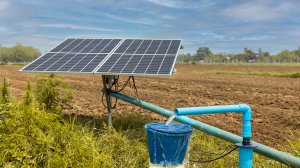Solar-powered PUE systems unlock more revenue, lower costs for African farmers, SMEs
Productive Use of Energy (PUE) applications powered by solar panels pose a massive opportunity for small businesses on the continent, particularly in the agricultural space, to increase revenue and achieve lower operational costs.
The Africa Solar Industry Association (Afsia) on May 4 published its ‘Productive Use Catalogue’, which unpacks the definition of PUE, as many stakeholders have varying definitions; its different applications; how beneficial it has been for many companies and end-users; and what could be expected in the near future.
Afsia CEO John van Zuylen explained in a webinar that PUE was a means of powering subsistence economies with clean energy sources, including solar, to generate income and increase productivity across different sectors including agriculture, industry, commercial and services.
PUE solutions such as solar fridges and solar irrigation had enabled many business owners in remote areas to make more money, Van Zuylen pointed out.
Afsia’s catalogue distinguishes between solar home systems (SHSs), mini-grids and PUE systems through its ability to contribute to direct income generation.
While SHS and mini-grid systems mainly provide electricity for households, hospitals and small and medium-sized enterprises (SMEs), PUEs such as solar-powered refrigerators and irrigation systems facilitate remote business activities and enable, facilitate or contribute to revenue generation.
Depending on its final use, a specific solution can be considered as PUE or not.
Some applications are more for public service or raising quality of life, and not necessarily raising the income of the user.
Most often, the source of PUE is renewable.
PUE presented a unique opportunity to drive renewable energy consumption and promote economic growth, though its adoption remained low owing to affordability challenges, Van Zuylen stated.
Access to end-user finance is, therefore, key to accelerate the adoption of PUE in sub-Saharan Africa.
“It may take a few years for PUE products to become commercially attractive, but some of the products are already on the right path,” Van Zuylen said, citing solar water pumps as an option that could be easily accelerated.
CATALOGUE FEATURES
In explaining what the catalogue contains, Van Zuylen said it focuses exclusively on solar-powered PUE solutions and the change in equipment or machinery required to become solar-powered.
The catalogue highlights agriculture, commercial, services and private use as sectors of interest.
In agriculture, applications that can benefit highly from solar-powered PUE systems include cold storage, solar freezing, solar irrigation, milling, drying, oil pressing, egg incubating, night fishing, milk chilling, electric fencing and pulping.
Looking at solar irrigation in the agricultural sector, Afsia research associate Kersy Nsengiyumva explained that this was the process of irrigating crops by using pumps powered by solar. It uses photovoltaic panels to convert sunlight into electricity, which then powers the motor of the pump.
The pump is typically used to pump water from a well, borehole or other nearby water sources for irrigation.
She distinguished between submersible solar pumps and surface solar pumps, the former of which were installed directly in the water source, such as a borehole. They require a strong system to pump the water up to ground level. Surface solar pumps are installed in the water body at ground level and are used for pumping water from lakes, rivers or other shallow water sources.
Nsengiyumva also distinguished between two types of pumps, the first being direct current (dc) pumps that are directly powered by solar panels without the need for an inverter. Although these pumps are highly efficient, their pumping capacity is directly proportionate to sunlight intensity.
In turn, alternating current (ac) pumps require an inverter to convert the dc power from solar panels to ac power to operate. They can also be connected to the grid.
Nsengiyumva cited an example whereby a farmer spends no capital expenditure (capex) or operating expenditure (opex) on a one-acre grain farm by using rain-fed irrigation, which would yield 2 t/y, for a $2 000 a year profit and $10 000 profit over five years.
By using a diesel-driven pump for irrigation, the capex rises to $250 and the operating expenditure to $3 a day; however, yield then increases to 4.5 t/y for a profit of $3 450 a year.
Using a solar pump, capex increases to $375, while opex reduces to $0, for the same yield as in the diesel-driven pump scenario, for a higher profit of $4 500 a year.
Similarly, using a solar pump with a pay-as-you-go system, for capex of $30 and opex of $0.67 a day, the same 4.5 t/y yield can be generated for a $4 257 yearly profit.
The Afsia catalogue contains a list of solar irrigation companies, as well as those offering solar-powered cold storage and other agroprocessing technologies.
CASE IN POINT
Farmers supported by global initiative Joint Programme on Accelerating Progress Towards Rural Women’s Economic Empowerment have managed to more than quadruple the yield from their lands from an average 3 t/y of tomatoes to 13 t/y of tomatoes, and from 1 t/y of green peppers per hectare to 15 t/y per hectare, by using a solar-powered irrigation system.
The system has allowed the farmers to stop suffering operational losses of about $184 a month and rather generate $1 848 of earnings per season.
Moreover, Kenya-based Zuhura Solutions cofounder Llyord Mwaniki says the company’s Halisi Trolley serves as a complete solar-powered street food vending solution.
The cart allows vendors to eliminate the time and cost of sourcing and maintaining charcoal levels to heat food, which is the conventional method for vendors.
On a full charge, the trolley can provide heat for about 12 hours and allows vendors to precisely control the temperature of their vending cart, as well as provide agency over when and where they work.
The vendors have been able to double or triple, in many instances, their revenue, while bringing down costs.
For example, although the charcoal trolley is highly affordable at $150 apiece, the daily opex cost fluctuates relative to coal prices, with the prevailing average being $9.5 a day, resulting in $18 of revenue daily and $8.5 of profit daily.
Using a solar-powered Halisi trolley, capex increases to $800, but opex reduces to $6.5 a day, with revenue amounting to $23 a day and profits amounting to $16.5 a day.
Using a pay-as-you-go solar trolley, capex comes to $160 and opex to $9.5, while revenue amounts to $23 a day and profit to $13.5 a day.
While the Halisi Trolley keeps food warm for up to 16 hours, the cooking of food can be done using another trolley the company offers, which runs on biofuels.
RURAL SOLUTION
Swiss energy access company Mpower Ventures COO Michael Eschmann discussed the company’s use of a commercialised range of plug-and-play productive use appliances to increase revenue or lower costs for customers, such as solar fridges, televisions, fans, lights, pumps, sprayers, generators and even small cotton harvesters.
The company is currently active in Zambia, Cameroon, Botswana, Zambia, Togo, Namibia and Ghana through local teams or local partners.
Unpacking how the company’s solution of energy hubs came about, Eschmann said the distribution part is what most often makes mini-grid systems complicated. It also comprises up to 50% of total project cost. Smart meters alone can cost up to $150, he points out.
There is also a high per customer connection cost, which costs at least $1 000 up to $5 000. Therefore, Mpower installs solar-powered energy hubs, which is a containerised solution, with energy services being delivered to customers at a lowered cost.
The energy hub provides for a complete business model for the hub manager and allows for diversified revenue streams depending on the services offered. The service provider pays a small percentage of their revenue as rent to the hub manager. The hub can be tailored to what is required in a village.
Eschmann said rural electrification programmes should focus on least-cost energy service delivery. What level of energy service had been made available to the population, and for how long, was what really mattered and effected change, he stated.
Comments
Press Office
Announcements
What's On
Subscribe to improve your user experience...
Option 1 (equivalent of R125 a month):
Receive a weekly copy of Creamer Media's Engineering News & Mining Weekly magazine
(print copy for those in South Africa and e-magazine for those outside of South Africa)
Receive daily email newsletters
Access to full search results
Access archive of magazine back copies
Access to Projects in Progress
Access to ONE Research Report of your choice in PDF format
Option 2 (equivalent of R375 a month):
All benefits from Option 1
PLUS
Access to Creamer Media's Research Channel Africa for ALL Research Reports, in PDF format, on various industrial and mining sectors
including Electricity; Water; Energy Transition; Hydrogen; Roads, Rail and Ports; Coal; Gold; Platinum; Battery Metals; etc.
Already a subscriber?
Forgotten your password?
Receive weekly copy of Creamer Media's Engineering News & Mining Weekly magazine (print copy for those in South Africa and e-magazine for those outside of South Africa)
➕
Recieve daily email newsletters
➕
Access to full search results
➕
Access archive of magazine back copies
➕
Access to Projects in Progress
➕
Access to ONE Research Report of your choice in PDF format
RESEARCH CHANNEL AFRICA
R4500 (equivalent of R375 a month)
SUBSCRIBEAll benefits from Option 1
➕
Access to Creamer Media's Research Channel Africa for ALL Research Reports on various industrial and mining sectors, in PDF format, including on:
Electricity
➕
Water
➕
Energy Transition
➕
Hydrogen
➕
Roads, Rail and Ports
➕
Coal
➕
Gold
➕
Platinum
➕
Battery Metals
➕
etc.
Receive all benefits from Option 1 or Option 2 delivered to numerous people at your company
➕
Multiple User names and Passwords for simultaneous log-ins
➕
Intranet integration access to all in your organisation






















